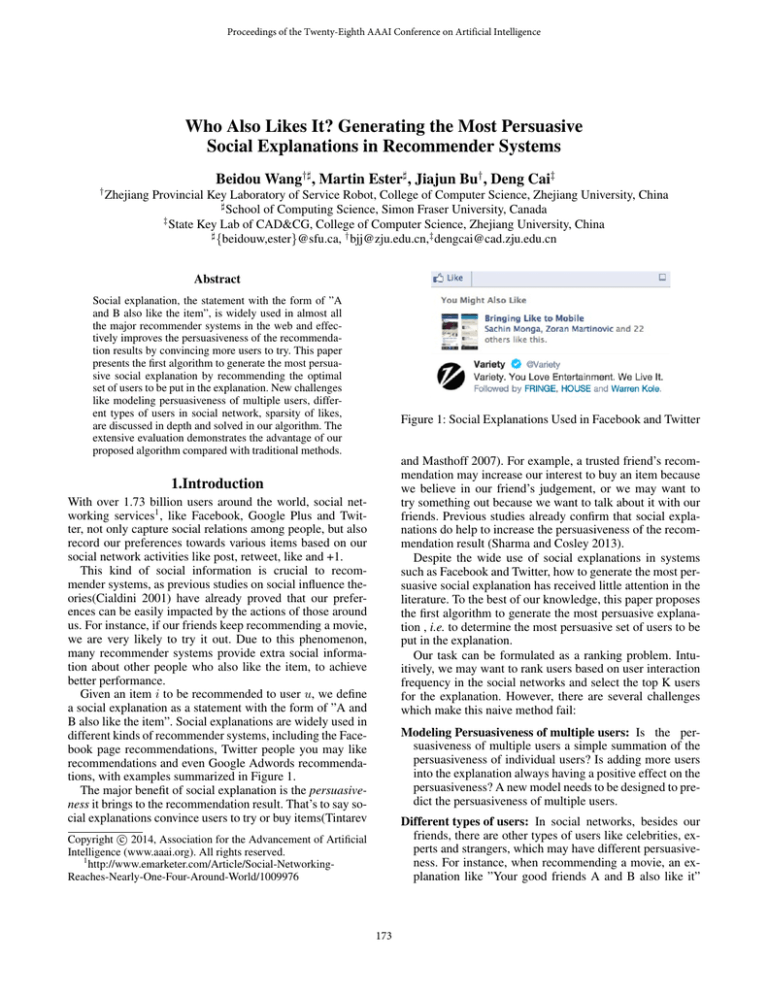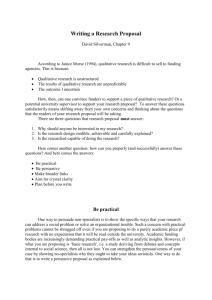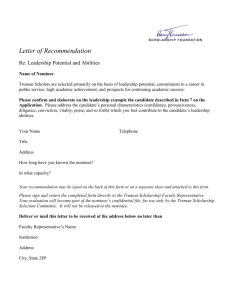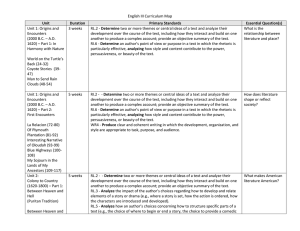
Proceedings of the Twenty-Eighth AAAI Conference on Artificial Intelligence
Who Also Likes It? Generating the Most Persuasive
Social Explanations in Recommender Systems
Beidou Wang†] , Martin Ester] , Jiajun Bu† , Deng Cai‡
†
Zhejiang Provincial Key Laboratory of Service Robot, College of Computer Science, Zhejiang University, China
]
School of Computing Science, Simon Fraser University, Canada
‡
State Key Lab of CAD&CG, College of Computer Science, Zhejiang University, China
]
{beidouw,ester}@sfu.ca, † bjj@zju.edu.cn,‡ dengcai@cad.zju.edu.cn
Abstract
Social explanation, the statement with the form of ”A
and B also like the item”, is widely used in almost all
the major recommender systems in the web and effectively improves the persuasiveness of the recommendation results by convincing more users to try. This paper
presents the first algorithm to generate the most persuasive social explanation by recommending the optimal
set of users to be put in the explanation. New challenges
like modeling persuasiveness of multiple users, different types of users in social network, sparsity of likes,
are discussed in depth and solved in our algorithm. The
extensive evaluation demonstrates the advantage of our
proposed algorithm compared with traditional methods.
Figure 1: Social Explanations Used in Facebook and Twitter
and Masthoff 2007). For example, a trusted friend’s recommendation may increase our interest to buy an item because
we believe in our friend’s judgement, or we may want to
try something out because we want to talk about it with our
friends. Previous studies already confirm that social explanations do help to increase the persuasiveness of the recommendation result (Sharma and Cosley 2013).
Despite the wide use of social explanations in systems
such as Facebook and Twitter, how to generate the most persuasive social explanation has received little attention in the
literature. To the best of our knowledge, this paper proposes
the first algorithm to generate the most persuasive explanation , i.e. to determine the most persuasive set of users to be
put in the explanation.
Our task can be formulated as a ranking problem. Intuitively, we may want to rank users based on user interaction
frequency in the social networks and select the top K users
for the explanation. However, there are several challenges
which make this naive method fail:
1.Introduction
With over 1.73 billion users around the world, social networking services1 , like Facebook, Google Plus and Twitter, not only capture social relations among people, but also
record our preferences towards various items based on our
social network activities like post, retweet, like and +1.
This kind of social information is crucial to recommender systems, as previous studies on social influence theories(Cialdini 2001) have already proved that our preferences can be easily impacted by the actions of those around
us. For instance, if our friends keep recommending a movie,
we are very likely to try it out. Due to this phenomenon,
many recommender systems provide extra social information about other people who also like the item, to achieve
better performance.
Given an item i to be recommended to user u, we define
a social explanation as a statement with the form of ”A and
B also like the item”. Social explanations are widely used in
different kinds of recommender systems, including the Facebook page recommendations, Twitter people you may like
recommendations and even Google Adwords recommendations, with examples summarized in Figure 1.
The major benefit of social explanation is the persuasiveness it brings to the recommendation result. That’s to say social explanations convince users to try or buy items(Tintarev
Modeling Persuasiveness of multiple users: Is the persuasiveness of multiple users a simple summation of the
persuasiveness of individual users? Is adding more users
into the explanation always having a positive effect on the
persuasiveness? A new model needs to be designed to predict the persuasiveness of multiple users.
Different types of users: In social networks, besides our
friends, there are other types of users like celebrities, experts and strangers, which may have different persuasiveness. For instance, when recommending a movie, an explanation like ”Your good friends A and B also like it”
c 2014, Association for the Advancement of Artificial
Copyright Intelligence (www.aaai.org). All rights reserved.
1
http://www.emarketer.com/Article/Social-NetworkingReaches-Nearly-One-Four-Around-World/1009976
173
users is the most persuasive explanation(Herlocker, Konstan, and Riedl 2000). Explanations for recommendation are
predominantly based on heuristics(Tintarev and Masthoff
2007), but there are also works based on case-based reasoning(Doyle, Tsymbal, and Cunningham 2003) and model
based approaches(Lea, Spears, and de Groot 2001).
Explanations can be used for multiple purposes in recommender systems. Tintarev et. al. summarized that there
were 7 major aims of recommendation explanations, including transparency, scrutability, trust, effectiveness, persuasiveness, efficiency and satisfaction(Tintarev and Masthoff
2007). Previous studies usually focus on achieving one or a
few of above mentioned aims. Trade offs may exist between
different aims of recommendation. Bilgic et. al. pointed out
that a system optimizing the persuasiveness of explanations
may not be helpful for accurately estimating the quality of
an item(effectiveness aim)(Bilgic and Mooney 2005). In our
paper we only consider the persuasiveness aim of social explanation, because this aim is the most important for increasing user interactions and ad click rates.
With the rapid growth of social network, social networking services now capture not only users’ social relations but
also users’ social interactions, which are both beneficial for
recommendation explanation. Many large web service suppliers like Facebook and Netflix, have already started to use
social explanations in their recommender systems(Papadimitriou, Symeonidis, and Manolopoulos 2012). Previous studies confirmed that users from our social network friends performed better in social explanations compared with users derived from similar neighbors(Tintarev and Masthoff 2007).
Sharma et. al. also confirmed that social explanation did
help to increase the persuasiveness of recommendation result based on real user studies on social explanation. However, this work only considers social explanations made up
of single users and only test performance of naive strategies
like using the close friends in social explanations(Sharma
and Cosley 2013). To the best of our knowledge, generating
the most persuasive set of users for social explanation has
never been studied in previous works.
will have different persuasiveness than ”Your good friend
A and president Barack Obama also like it”.
Sparsity of likes: Social explanation relies on other people who also like the item. However, in real life we usually have a limited number of social network friends and
a huge number of items that need to be recommended,
which results in a severe sparsity of like information. In
many cases, when we try to generate a social explanation
for an item recommendation, it may turn out none of our
friends has ever tried it.
Because of the above mentioned challenges, a novel two
phase ranking approach is proposed to generate the most
persuasive social explanation.
Our research problem can be defined as: for item i to be
recommended to user u, determine the most persuasive set of
up to k users from the social network S. The social network
S is modeled as a directed graph with weighted edges derived from various social network relations and user interactions, and with different types of nodes standing for different
types of users (e.g. normal friends, celebrities and experts).
Persuasiveness, defined as the power of convincing users to
try(Tintarev and Masthoff 2007), is evaluated by real user’s
rating on the persuasiveness of various explanations, which
will be explained in details in section 4 and 5.
Our proposed ranking model is made up of two phases.
In the first phase, for recommending an item i to a user u,
the persuasiveness score of a single candidate user c is predicted based on a Support Vector Regression (SVR) framework, considering features including social relations, social
user interactions, user types and social influence of the candidate. In the second phase, we predict the persuasiveness
score of a set of users based on the predicted persuasiveness of the individual users, by taking the marginal net utility
of persuasiveness, credibility of the explanation and reading
cost into consideration.
The main contributions of the paper are as follows:
1. We are the first to introduce the problem of generating the
most persuasive social explanation of a recommendation.
3. Problem Definition
2. We propose a two phase ranking method adopting a machine learning approach to generate the most persuasive
explanation, by finding the optimal set of users to be put
in a social explanation.
We formalize the problem of generating the most persuasive social explanation as a ranking problem. Given a set
of users U and a set of items I, for recommending an item
i ∈ I to a user u ∈ U , we define a social explanation as the
statement ”Users e1 ,e2 ,...,ek also like item i”, with given k.
We define the candidates C as C ⊆ U, ∀c ∈ C, c likes i.
We define Ck as all the subsets of C with cardinality k,
Ck = {E E ⊆ C, |E| = k}. Since the only difference
between two social explanations is the two size-k sets of
candidate users, our task is essentially to predict the persuasiveness score for all the elements in Ck and find out the set
E with the highest predicted score. Assuming that the predicted score reflects the persuasiveness of the explanation
as perceived by the users, we claim our algorithm aims to
generate the most persuasive social explanation.
We also define the social network S as a directed graph,
in which each node v stands for a user u and each edge e
stands for either one type of social relation (e.g. follow in
3. The sparsity of like information is addressed by taking
into account not only friends, but also celebrities and experts from the social network.
2. Related Work
Explanations in intelligent systems originated in the area of
Expert Systems (Andersen et al. 1989)(Buchanan and Shortliffe 1984). Explanations convince a user to accept a recommendation more easily because it provides transparency
to the recommender system(Papadimitriou, Symeonidis, and
Manolopoulos 2012). Herlocker et al. provided one of the
first studies on explanations in recommender systems by
evaluating 21 types of interfaces of recommendation explanations and found out that showing the ratings of similar
174
User types features (U T ): In our model, users are divided
into 4 types, i.e. friends, celebrities, experts and strangers.
It’s especially worth mentioning 2 types of users: celebrities and experts. For celebrities, like movie stars and political leaders, their influence in real life may enable them
to cast substantial persuasiveness on a user even if no explicit social relations or interactions exist between them.
For experts, like movie critics in movie recommendation,
even if they are unknown to the user, their expertise can
make their endorsement very persuasive. These two types
of users help to significantly expand candidate user set,
which helps to solve the sparsity of like data problem.
We define user types feature U T (c, i) as two ”1-of-K”
vectors. One records the type of candidate c and the other
records the domain of c (for celebrities and experts). It’s
worth noting that whether a user is an expert is related
with the domain of the item we recommend.
User Influence features (IN F ): Intuitively, the more influential a user is, the more trust worthy he looks, which
increases his persuasiveness. Moreover, for celebrities,
high influence may even offer them the power to bring
persuasiveness to users without explicit social relations.
We define the social influence feature IN F (c) as a set of
scalar features, i.e. the number of followers, the average
number of retweet, reply, like for each tweet.
Table 1: Features Used In SVR Model
Category
Used Features
User relation
Whether is a follower, followee, active follower; Common Friends Number
Reply, Retweet, Like, Mention (Note these
interactions are directed)
User type (experts, celebrities, friends and
strangers), Expert/Celebrity Domain(18
large domains)
Follower number, average number of reply,
like, retweet for each tweet
User interaction
User type
User Influence
Twitter) or some social interactions (e.g. retweet, mention,
reply in Twitter) between two users. The nodes are with different types, corresponding to different types of users (e.g.
celebrities, experts and friends).
4. Two-Phase Ranking Model for Social
Explanation
The key task is to predict the persuasiveness scores for Ck ,
the size-k sets of candidate users and we use a machine
learning approach to train a two-phase ranking model for
this task. In the first phase, we predict the persuasiveness
score for a single user with a Support Vector Regression
(SVR) based model considering various types of features
derived from the user’s social network. In the second phase,
after gaining persuasiveness scores of single users, we adopt
them to evaluate the persuasiveness scores of Ck based on
our new multiple-user persuasiveness prediction model.
4.1.2 Ranking Function Many machine learning models
can be used as a ranking function to predict the persuasiveness score for a single user. We choose support vector regression (SVR) , because it is a sophisticated proven regression
algorithm which is adaptive to complex systems and with a
good generalization ability (Wu et al. 2008).
Let’s assume that we are recommending an item i to user
u considering a candidate user c, we use SVR to compute a
score to serve as the persuasiveness score per(u, i, c), which
denotes the persuasiveness c brings to the social explanation.
We define xu,i,c as the feature vector corresponding to the
tuple (u, i, c).
xu,i,c = {U R(u, c), U I(u, c), U T (c, i), IN F (c)} (1)
The set of training data is as {(x1 , y1 ), ..., (xn , yn )},
where xj ⊂ Rm stands for the feature vector for a tuple
(u, i, c) in which m is the number of feature dimensions, and
yj ⊂ R stands for the corresponding persuasiveness value.
A generic SVR estimating function is of the form:
f (x) = (w · φ(x)) + b
(2)
w ⊂ Rm ,b ⊂ R and φ stands for a nonlinear transformation from Rm to high-dimensional space. The core goal
of SVR is to learn the value of w and b to minimize risk of
regression.
n
X
1
Risk(f ) = B
L(f (xj ) − yj ) + ||w||2
(3)
2
j=0
4.1 Phase I: Persuasiveness of a Single User
When recommending item i to user u, an SVR based ranking
model is used to predict the persuasiveness score for each
candidate user c and the model is made up of two parts: the
ranking features for each tuple (u, i, c) and a ranking function to predict persuasiveness per(u, i, c) given the ranking
features.
4.1.1 Ranking Features We consider 4 types of features
in our SVR model, which is summarized in table 1.
User relation features (U R): We always trust our friend
and a friend’s endorsement of a recommendation will definitely make it more convincing. We define user relation
features U R(u, c) as a boolean value vector with each dimension representing whether one type of relation exists
between (u, c).
User interaction features (U I): According to previous
studies on social networks, users only communicate with
a few of explicitly declared friends(Wang et al. 2013).
Fortunately, user interaction features like comments,
retweets, likes, enable us to model some implicit networks which can be better indicators of actual social
relationships between users. We define user interaction
features U I(u, c) as a vector with each dimension
denoting one type of user interaction and the value
of each dimension is the normalized frequency of the
corresponding user interaction between (u, c).
L(·) is a loss function and B is a constant used to determine penalties to estimation errors which is determined with
grids search and cross-validation techniques. We experiment
the performance of different kernel functions and choose
kernel function with best performance (RBF kernel). Details
of SVR can be found in (Smola and Schölkopf 2004).
175
4.2 Phase II: Persuasiveness of a set of Users
The Law Of Diminishing Marginal Utility states that the
marginal utility of a product or service drops while the consumption of it increases. We argue that the same rule should
also be applied to persuasiveness summation, which is to
say that the additional persuasiveness the social explanation
gains after adding an additional candidate decreases as the
number of added user increases.
In our work, we adopt the Cobb-Douglas utility function(Cobb and Douglas 1928). The function is widely used
due to its mathematical characteristic: the ability of modeling the diminishing marginal utility. The functional form is:
Intuitively, to predict the persuasiveness score for a set of
users, we may think about adding up the single-user persuasiveness scores generated in phase I. However, the idea of
simple summation of individual users’ persuasiveness scores
may fail due to the following challenges.
Marginal utility diminishing rules of persuasiveness:
We argue that the persuasiveness follows the Law Of
Diminishing Marginal Utility. According to the marginal
net utility theory(Wang and Zhang 2011), in our task,
the marginal utility can be interpreted as the additional
persuasiveness the social explanation gains after adding
an additional candidate into the explanation, which
decreases as the number of added users increases. For
instance, if we already have several persuasive users, the
marginal utility of adding another persuasive user drops.
Therefore, it requires us to use a marginal utility model
to evaluate the summation of the persuasiveness.
Creditability & reading cost: Does adding more users always lead to a positive effect on the persuasiveness? The
answer is negative due to multiple reasons, among which
are the decrease of explanation credibility and increase of
reading cost, with details explained in section 4.2.2.
U (E) = loga
k
X
j=1
per(u, i, ej )+β
per(u, i, ej )
j=1
where a is a variable which can be trained with labeled data.
4.2.2 Credibility of Social Explanation & Reading Cost
Due to the sparsity of like information in social networks,
there may not always exist enough highly persuasive users
for social explanations. Based on our user study, adding less
persuasive users ( e.g. unacquainted candidates) may have
a negative effect on the persuasiveness. We believe that this
is because it may make the explanation look unreliable as it
adds a not so convincing candidate in the social explanation.
Pk
So we use k1 j=1 per(u, i, ej ), the average of persuasiveness of the k individual users as the credibility level of the
social explanation.
Users only have very limited time for reading the social
explanation. Adding too many candidates, may distract users
from noticing the real persuasive users in the explanation.
Moreover, adding too many users in the explanation may
make the users feel overwhelmed and decrease their interest
in accepting the recommendation. So we add a constant Ck
in (4), to represent the reading cost when the social explanation is made up of k different candidates.
Intuitively, we should add users into the explanation in a
descending order according to the persuasiveness score we
predicts for individual users in phase I. After adding an additional user, even though the summation of persuasiveness increases, the credibility of explanation decreases (because the
later added users are always less persuasive) and the reading
cost increases. Moreover, the marginal utility of adding additional candidate decreases with the increase of the number
of added users. So the best set of candidates requires the
best trade off of the summation of persuasiveness, the explanation credibility and the reading cost.
So we propose the following model to predict the persuasiveness score of a set of users. Given recommending item i
to user u, for a size-k set of candidates E, the persuasiveness
score P (E, u, i) is defined as
P (E, u, i) = αloga
k
X
4.3 Efficiency
Social networks are made up of millions of users, so strategies are required to guarantee the efficiency of our model.
Single Candidate Persuasiveness Prediction: In phase I
of our algorithm, for users who have large numbers of
friends in social network, we only consider the top N most
interactive friends (N is 10000 in our experiments), because frequently interacting friends are more persuasive
compared with infrequent ones. For experts, celebrities
and organizations, we only consider the ones with high
influence and from the corresponding domain of the recommended item.
k
1X
per(u, i, ej )+γCk
k j=1
(4)
Pk
where the first term loga j=1 per(u, i, ej ) stands for the
summation of persuasiveness of a set of individual candidates. The second term denotes the credibility of the explanation. The third term is a constant only related to the total
number of candidates in the explanation (k). α, β, γ are variables trained by a standard regression model based on a set
of labeled multiple-user social explanation data.
In our framework, we do not need to predict P (E, u, i) for
all elements of Ck , which will be time consuming. Details
are discussed in section 4.3.
Multiple Candidates Persuasiveness Prediction: In
phase II of our algorithm, according to our objective
function, we do not need to consider every set of
candidate users. Instead, we only need to consider
the top k candidate users with the highest single user
persuasiveness score from phase I. Due to the monotonicity property of our objective function (4) in phase II,
P (E ∪ {ej }, u, i) ≥ P (E ∪ {ek }, u, i), if per(u, i, ej ) ≥
per(u, i, ek ). So we only need to decide whether we
4.2.1 Persuasiveness Summation Based on Cobb-Douglas
Utility Function Marginal utility is used in economics
and marketing research to represent the additional utility
when consuming an additional unit of a product or service.
176
should use the top1, top2,..., top k users to form our
explanation.
Table 2: Algorithm Performance Comparison
Explanation Strategy
Random Friends
Good Friends
2-phase Ranking
Sparsity of Relation and Like: For ordinary users, the
number of friends in a social network is usually limited,
which ensures the efficiency of Phase I. Moreover, due to
the sparsity of like data, when recommending item i to u,
the number of friends who like i is limited, which ensures
the efficiency of our algorithm. The impact of the sparsity
will be evaluated in the section 6.
Average Rating
4.17
4.46
5.07
Std. Dev
1.81
2.01
1.86
Coverage
75.2%
97%
100%
Table 5: Influence of Adding More Users
Average Rating
2 users
5.7
2 users+ 1 unacquainted Users
4.3
5. Experiments
6. Results & Analysis
5.1. Experiment Design & Data Collection
6.1 Algorithm Performance Comparison
In our experiment, participants are given a recommendation scenario in which we offer recommendations on TV
series with various kinds of social explanations. Users rate
the persuasiveness of the social explanation in a 7-level Likert scale approach, since many psychometricians advocate
using seven levels(Nunnally, Bernstein, and Berge 1967).
We then collect the participants’ social relation and interaction data from Weibo, the largest micro-blogging system
in China. Users related with the participants, celebrities and
experts are also extracted from the social network to serve
as candidates. To simulate the sparsity of like information,
interest in TV series is randomly assigned to all the users we
crawled. Participants are trained to only rate on the persuasiveness of social explanation in spite of the actually preference of the recommended item and assume all the social
explanations generated are real.
30 participants are invited to generate 3,243 ratings for
social explanations (2030 for training and 1213 for testing).
We collect 49,183 users from social network as candidates,
along with 37,072 user relations and 120,764 interactions.
An A/B test is conducted to compare our algorithms with
baselines and the result is shown in table 2. Based on user’s
average rating on the persuasiveness of the social explanation, our algorithm shows a 21% improvement compared
with RF and a 14% improvement compared with GF . The
result is in accordance with our expectation. GF outperforms RF , as besides user’s social relations, GF also takes
the frequency of interactions into consideration and intuitively close friends will be more persuasive than ordinary
friends. While our algorithm performs the best, which benefits from the exploitation of all kinds of additional features
from social network, like user types and user influence and
a careful designed persuasiveness model for a set of users.
It’s also worth noting that both RF and GF cannot generate social explanations for all the recommendation due to
the sparsity of like data, for instance, in scenarios that none
of a user’s friends has ever tried an item. However, our 2phase ranking algorithm can still provide social explanations
in these situation, by adding persuasive celebrities and experts into explanations. We define the percentage of recommendations in which one strategy can be used to generate
the social explanation as coverage, with results in Table 2.
5.2. Comparison Algorithms
• Random Friends (RF). Used as a baseline, in RF, when
recommending item i to u, we randomly pick k friends of
u who also like i to generate the social explanation.
6.2 Feature Importance Evaluation
• Good Friends (GF). Used as a baseline, in GF, when recommending i to u, we rank all candidates who also like
i in a descending order of their of interaction frequencies
with u and use the top k candidates in the explanation.
Based on table 3, all of the 4 types of features we considered
do help to improve the precision of persuasiveness score prediction for a single user. Social relations and social interactions are the most important 2 types of features. It’s a little
surprising that social relation features are more important
than the social interaction features and we propose two possible reasons. First, since we extract our data from a microblogging system, a user’s interactions like retweet and reply with a candidate c may only mean that he is interested
in certain posts published by c, instead of acquainted with
c or trusting c. Second, spam accounts like to reach out to
users actively in micro-blogging systems, which may result
in noise in the user interaction data.
Based on table 4, all the three factors we considered in
modeling the persuasiveness of a set of users contribute to
the improvement of accuracy in prediction and the credibility factor is of the most significance.
• Single User Persuasiveness Contrast Algorithm (SC). To
test how different types of features affect the precision on
predicting the persuasiveness of a single user, we eliminate one type of features at a time from our single user
prediction model.
• Multiple User Persuasiveness Contrast Algorithm (MC).
To test how persuasiveness summation, credibility and
reading cost affect the performance of predicting the persuasiveness for a set of users, we eliminate each of them
at a time from our prediction model for multiple users.
In all of the baselines and our algorithm, k is set to 3.
177
Table 3: Feature Comparison for Single User Persuasiveness Prediction
Evaluation Measure
MSE
SC withAll
2.34
SC withNoRelation
2.99
SC withNoInteraction
2.47
SC withNoTypes
2.40
SC withNoInfluence
2.37
Table 4: Feature Comparison for Predicting Persuasiveness for a set of Users
Evaluation Measure
MSE
MC withAll
2.03
MC withNoPersuasivnessAggregation
2.07
Random Friends
24
Good Friends
130
2-phase Ranking
330
2.075
Using Cobb−Douglas Utility
Simple Aggregation
2.07
2.065
MSE
2.06
2.055
2.05
2.045
2.04
1
1.05
1.1
1.15
1.2
MC withNoReadingCost
2.05
479 and the total number of experts and celebrities we considered is 1792, which ensures the efficiency of computing
the score for all individual candidates in Phase I.
The sparsity of like information will result in problems
of the coverage of the recommendation. Traditional social
explanation strategies (e.g. GF, RF) that consider only explicit friends often cannot generate a valid explanation because none of the user’s friends has ever tried the item. In our
approach, by incorporating the celebrities and experts without explicit user relations, the candidate set is effectively expanded. According to table 6, our algorithm almost triples
the average size of the candidate set compared with GF .
However, it is worth noting that even though our algorithm has greatly expanded the candidate set, due to the sparsity of likes, the average size of candidate set (330) is relative
small, which further improves the efficiency of Phase II.
Table 6: Average Candidate Set Size Comparison
Size
MC withNoCredibility
2.16
1.25
7. Conclusion
a
In this paper, we present the first algorithm to generate the
most persuasive social explanation by recommending the
optimal set of users to be put in the explanation. A two-phase
ranking algorithm is proposed and inside our algorithm, we
present the first model for predicting the persuasiveness of a
set users, taking factors like marginal utility of persuasiveness, credibility of explanation and reading cost into considerations.
We find our algorithm gains the best performance compared with all the baselines and the sparsity of like is solved
by considering different types of users, like celebrities and
experts, who can bring persuasiveness to a user even if without explicit social relations between them. Based on our experiments, we also confirm that the aggregation of persuasiveness follows the marginal utility diminishing laws and
more users do not necessarily lead to more persuasiveness.
Many future works can be further explored. For instance,
what if the predicted score of recommendation result is not
in accordance with the persuasiveness of the social explanation? How to cope with the trade off of the two factors to
achieve the best result can be an interesting future research
topic.
Figure 2: Marginal Utility Diminishing Test
6.3 Marginal Utility Diminishing Test
In section 4, we argue that the summation of the persuasiveness for multiple candidates should follow Marginal Utility
Diminishing Law, so a contrast experiment is designed to
test it. For the persuasiveness summation term in equation
(4), we compared using Cobb-Douglas Utility Function with
simply summing the persuasiveness score of all the individual candidates. As shown in Figure 2, the best performance
is achieved by adopting Cobb-Douglas Utility Function with
parameter a set to 1.05, which confirms our argument.
6.4 Influence of Adding More Users
To test whether adding more users will always do no harm
to the social explanation, a user study is designed. We first
generate a set of explanations made up of two persuasive
users and we then add an unacquainted user into each explanation. We ask users to rate these explanations and as shown
in table 5, a 25% decrease of the persuasiveness rate occurs
after adding the unacquainted user, which further confirms
our assumptions in section 4.2.2.
Acknowledgment
This paper is supported by the National Basic Research Program of China (973 Program) under Grant
2013CB336500, the National Science Foundation of China
(61173186) and the National Key Technology R&D Program(2012BAI34B01).
6.5 Impact of Sparsity
For ordinary users, the average number of friends is relatively small compared with total number of users from social network. In our data set, the average number of friends is
178
References
Wu, X.; Kumar, V.; Ross Quinlan, J.; Ghosh, J.; Yang, Q.;
Motoda, H.; McLachlan, G.; Ng, A.; Liu, B.; Yu, P.; et al.
2008. Top 10 algorithms in data mining. Knowledge and
Information Systems 14:1–37.
Andersen, S. K.; Olesen, K. G.; Jensen, F. V.; and Jensen, F.
1989. Hugin-a shell for building bayesian belief universes
for expert systems. In IJCAI, volume 89, 1080–1085.
Bilgic, M., and Mooney, R. J. 2005. Explaining recommendations: Satisfaction vs. promotion. In Beyond Personalization Workshop, IUI, volume 5.
Buchanan, B. G., and Shortliffe, E. H. 1984. Rule Based
Expert Systems: The Mycin Experiments of the Stanford
Heuristic Programming Project (The Addison-Wesley series
in artificial intelligence). Addison-Wesley Longman Publishing Co., Inc.
Cialdini, R. B. 2001. Influence: Science and practice.
Boston: Allyn & Bacon.
Cobb, C. W., and Douglas, P. H. 1928. A theory of production. The American Economic Review 18(1):139–165.
Doyle, D.; Tsymbal, A.; and Cunningham, P.
2003.
A review of explanation and explanation in case-based
reasoning. Dublin, Trinity college https://www. cs. tcd.
ie/publications/tech-reports/reports 3.
Herlocker, J. L.; Konstan, J. A.; and Riedl, J. 2000. Explaining collaborative filtering recommendations. In Proceedings
of the 2000 ACM conference on Computer supported cooperative work, 241–250. ACM.
Lea, M.; Spears, R.; and de Groot, D. 2001. Knowing
me, knowing you: Anonymity effects on social identity processes within groups. Personality and Social Psychology
Bulletin 27(5):526–537.
Nunnally, J. C.; Bernstein, I. H.; and Berge, J. M. t. 1967.
Psychometric theory, volume 226. McGraw-Hill New York.
Papadimitriou, A.; Symeonidis, P.; and Manolopoulos, Y.
2012. A generalized taxonomy of explanations styles for
traditional and social recommender systems. Data Mining
and Knowledge Discovery 24(3):555–583.
Sharma, A., and Cosley, D. 2013. Do social explanations
work?: studying and modeling the effects of social explanations in recommender systems. In Proceedings of the 22nd
international conference on World Wide Web, 1133–1144.
International World Wide Web Conferences Steering Committee.
Smola, A., and Schölkopf, B. 2004. A tutorial on support
vector regression. Statistics and computing 14(3):199–222.
Tintarev, N., and Masthoff, J. 2007. A survey of explanations in recommender systems. In Data Engineering Workshop, 2007 IEEE 23rd International Conference on, 801–
810. IEEE.
Wang, J., and Zhang, Y. 2011. Utilizing marginal net utility
for recommendation in e-commerce. In Proceedings of the
34th international ACM SIGIR conference on Research and
development in Information Retrieval, 1003–1012. ACM.
Wang, B.; Wang, C.; Bu, J.; Chen, C.; Zhang, W. V.; Cai,
D.; and He, X. 2013. Whom to mention: expand the diffusion of tweets by@ recommendation on micro-blogging
systems. In Proceedings of the 22nd international conference on World Wide Web, 1331–1340. International World
Wide Web Conferences Steering Committee.
179





